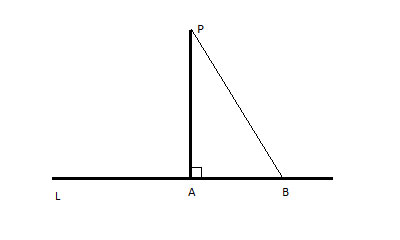The Shortest Distance Theorem states that the shortest distance between a point P, and a line, l, is the perpendicular line from P to l. It is also called the "perpendicular distance."
It is simple to prove this theorem using the Pythagorean Theorem.
Problem
Prove that the shortest distance between a point P, and a line, l, is the perpendicular line from P to l.

Strategy
Since the perpendicular line from P to l forms a right angle, we will try to use what we know about right triangles, and the theorem we have about lengths of the sides of a right triangle - the Pythagorean Theorem.
Any line from P to l other than the perpendicular line PA will form a right triangle, where that new line is the hypotenuse.
From the Pythagorean Theorem, we know that |PB|2= |PA|2+ |AB|2. Since both PA and AB have non-zero length, their squares are positive numbers.
If |PB|2 is equal to |PA|2 plus some positive number (|AB|2), it is bigger than |PA|2 and thus |PB| > |PA|, for every point B other than the one where the perpendicular line meets the line l.
Proof
(1) PA ⊥l //Given
(2) ΔPAB is a right triangle //Definition of a right triangle, from (1)
(3) |PB|2= |PA|2+ |AB|2 //Pythagorean Theorem
(4) |AB|2>0 //Square of a non-zero number is positive
(5) |PB|2>|PA|2 //(3),(4)
(6) |PB|>|PA| //Lines have positive lengths, so the square root is positive.
